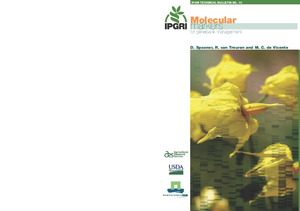Molecular markers for genebank management
In the last decade, the use of DNA markers for the study of crop genetic diversity has become routine, and has revolutionized biology. Increasingly, techniques are being developed to more precisely, quickly and cheaply assess genetic variation. These techniques have changed the standard equipment of many labs, and most germplasm scientists are expected to be trained in DNA data generation and interpretation. The rapid growth of new techniques has stimulated this update of IPGRI's Technical Bulletin No. 2, ”Molecular tools in plant genetic resources conservation: a guide to the technologies” (Karp et al. 1997b). Our goal is to update DNA techniques from this publication, to show examples of their applications, and to guide genebank researchers towards ways to maximize their use. This bulletin reviews basic qualities of molecular markers, their characteristics, the advantages and disadvantages of their applications, and analytical techniques, and provides some examples of their use.There is no single molecular approach for many of the problems facing genebank managers, and many techniques complement each other. However, some techniques are clearly more appropriate than others for some specific applications. In an ideal situation, the most appropriate marker(s) can be chosen irrespective of time or funding constraints, but in other cases the choice of marker(s) will depend on constraints of equipment or funds. The purpose of this publication is to explain the characteristics of different markers and guide to their use through a number of real examples that represent well informed choices. What is most important is to choose a marker that can appropriately address well-defined questions through good experimental design, ideally leading to peer-reviewed scientific publications. Experimental design has many definitions depending on the type of question being asked and on the field of science addressed. We use the term here in a very general way to cover all aspects of planning an experiment, including a clear definition of the question being addressed; knowledge of prior studies addressing the question; proper choice of molecular markers and of data used to address the question; knowledge of the characteristics, strengths and weaknesses of the data; sources of unexpected variation in the data; how much data are needed; proper methods to analyze the data; and limits to conclusions you can make from the results. One of the most important considerations before beginning any experiment is to address proper experimental design. Improper experimental design can make the work inconclusive, misleading, insignificant, and most likely unpublishable. Similarly, improvements in experimental design can change an uninspired study to a highly significant one with little to no increase in time and funds. Poor experimental design can waste significant resources and damage the reputation and impact of your genebank. It is beyond the scope of any publication to outline all possible pitfalls that can lead to poorly designed experiments, analyses or conclusions, and different considerations of proper experimental design need to be made in particular fields. This technical bulletin outlines some basic considerations regarding molecular marker types and analyses to lead the reader. There is no substitute, however, for basic knowledge of the biological questions being addressed, knowledge of the taxonomic group under consideration and a thorough literature review to ensure that similar work has not been done before. If limitations of any type hinder genebank and germplasm managers with regards to these factors, collaboration or consultation with experts is well worth the effort. Excellent reviews of methodology and data interpretation are presented in Weising et al. (1995), Hillis et al. (1996), Staub et al. (1996), Hillis (1997), Karp et al. (1997a,b) and Avise (2004). Hamrick and Godt (1997) present a review of isozyme data; Doebley (1992), Clegg (1993b) and Spooner and Lara-Cabrera (2001) present a review of molecular data for plant genetic resources and crop evolution; Bruford and Wayne (1993), Wang et al. (1994), Gupta et al. (1996), Powell et al. (1996a) and Weising et al. (1998) of microsatellite data; Wolfe and Liston (1998) on Polymerase Chain Reaction (PCR) related data. Schlötterer (2004) reviews the history and relative utility of different molecular marker types. Sytsma and Hahn (1997) present reviews of molecular studies in crop and non-crop plants. Some information from Spooner and Lara-Cabrera (2001) for crop diversity studies was used and updated; Spooner et al. (2003) was used for taxonomy studies. An overview of the main marker techniques and their comparative qualities is presented in the section titled, ”Overview of molecular technologies”. Applications of molecular techniques in genebank management and crop breeding are the subject of the following sections. The section titled, ”Future challenges” focuses on the current developments in molecular marker applications and future challenges that could result from these developments. Elements of experimental design are discussed throughout and some basic aspects of data analysis are discussed in ”Genebank management”.

